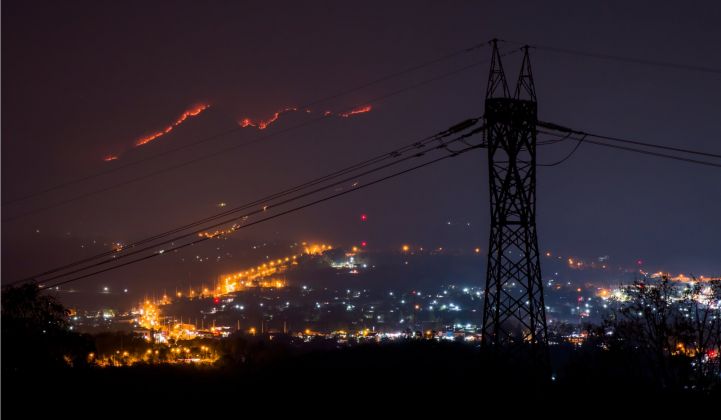Community-choice aggregators representing three San Francisco Bay Area counties have launched a 30-megawatt behind-the-meter battery solicitation aimed at protecting vulnerable customers and communities from the massive fire-prevention power outages of bankrupt utility Pacific Gas & Electric.
Tuesday’s requests for proposals from East Bay Community Energy (EBCE), Peninsula Clean Energy, Silicon Valley Clean Energy and municipal utility Silicon Valley Power are the latest step taken by state and local authorities to bolster solar-storage systems as a solution to the wildfire and power outage conundrum.
The goal is to equip up to 6,000 homes and hundreds of businesses in Alameda, San Mateo and Santa Clara counties with batteries, combined with new or existing solar systems. Proposals should focus on serving “low-income residents, customers with life-dependent medical equipment, and residents and businesses located in disadvantaged communities.”
PG&E’s multiday blackouts last month were a life-threatening event for sick and elderly people reliant on medical equipment, air conditioning or operating elevators to survive. They also underscored the lack of resources for communities left without power to charge cellphones, keep food and medicines chilled, and otherwise support the basics of modern life.
Tuesday’s solicitation earmarks half of the 30 megawatts of storage for residences, with the rest for multifamily properties and commercial buildings. Partner vendors will be selected early next year, with the goal of getting projects underway in time for the 2020 fire season.
From backup power to resource adequacy
Beyond these terms, the CCAs and Silicon Valley Power aren’t prescribing just how proposals could seek to meet their broader goals of lowering energy bills, increasing grid reliability and serving the grid at large. Some of the funding could well go to microgrids like the one installed at the city of Fremont, California’s Fire Station #6, the site of Tuesday’s press conference for the solicitation.
Other initiatives have focused on increased incentives for single- and multifamily housing. One example of this is the California Public Utilities Commission’s decision this summer to set aside $100 million in incentives to cover nearly the entire cost of a solar-battery system for disadvantaged or medically vulnerable residents of high-fire-risk regions. The carve-out from the state’s Self-Generation Incentive Program is meant to allow solar installers like Sunrun, Tesla, SunPower and others to seek out customers who’d otherwise be unable to afford such a system.
Tuesday’s joint solicitation is aimed at adding another layer of sophistication to home and business solar-battery systems, by integrating them in a way that allows them to serve as grid resources. Specifically, the CCAs want to aggregate the 30 megawatts of capacity to meet their Resource Adequacy requirements: their share of the resources needed to assure the state grid can remain reliable even during emergencies or times of peak demand.
That’s how East Bay Community Energy, which serves about 550,000 customers in Alameda County, set up this summer’s contract with Sunrun to provide half a megawatt of capacity from aggregated solar-battery systems by 2022. Sunrun plans to use the future Resource Adequacy capacity revenue to reduce the upfront cost of its BrightBox battery systems for East Bay Community Energy (EBCE) customers, centered on the disadvantaged community of West Oakland.
Tuesday’s solicitation isn’t the first effort by participating CCAs to bolster clean backup power in their service territories. Peninsula Clean Energy last month approved up to $10 million over three years to develop backup generation programs for medically vulnerable customers, emergency response centers and other infrastructure like police and fire stations. It and EBCE have also partnered with the Bay Area Air Quality Management District to determine top community shelter and emergency services sites for solar-plus-storage backup systems.
A growing role for CCAs as PG&E faces public takeover
The scope of Tuesday’s solicitation would dwarf these efforts. While Tuesday's solicitation doesn't provide any price or cost figures for the 30 megawatts it's seeking, a back-of-envelope calculation, using the California Public Utilities Commission's boosted incentive of $1 per watt for Self-Generation Incentive Program funding to cover the entire cost of a typical home solar-battery system, would imply a price tag of roughly $30 million.
The move also highlights the increasing role that CCAs are taking in California’s energy future. Across the state, 19 CCAs now buy power for more than 4 million customers, according to industry group CalCCA. Most of them are in PG&E territory, where nearly half of electric customer accounts are now served by a CCA, and more are set to join.
Some CalCCA members have asked the California Public Utilities Commission to consider transforming PG&E into a “wires-only” electricity distribution provider. Other public entities, such as the City of San Francisco, are seeking to buy PG&E’s grid infrastructure within their territories.
Gov. Gavin Newsom and state legislative leaders have proposed more drastic efforts to intervene in PG&E’s corporate structure and governance to correct its track record of safety failures. The operational failures of last month’s public safety power shutoff only strengthened those calls, with San Jose Mayor Sam Liccardo leading a political effort to explore turning the utility into a publicly owned cooperative.
But a public takeover of PG&E doesn't guarantee a more reliable future grid, as Dan Kalb, EBCE board chairman and Oakland councilmember, wrote in a Tuesday statement.
"We have a lot to do," he said, "including additional policies and regulations to further reduce heat-trapping emissions; hardening of our electrical transmission and distribution system; improved dedication to effective vegetation management, more clean energy locally, and serious consideration of taking over elements of PG&E by creating new public power authorities.”




